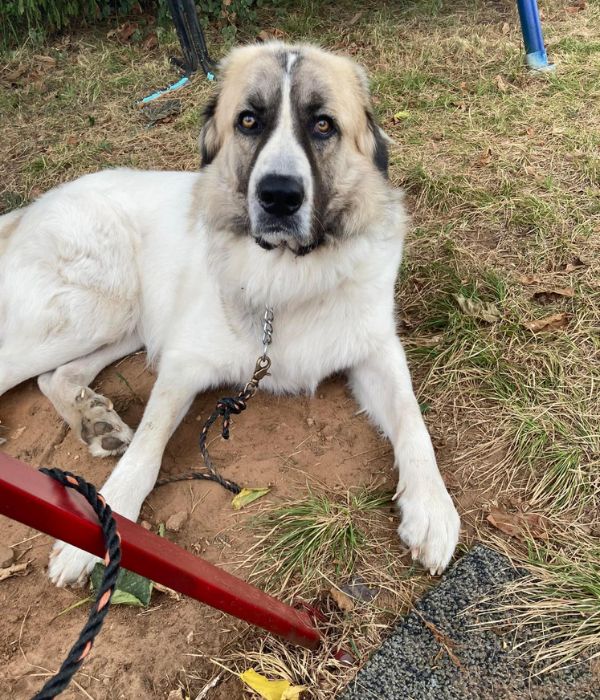If you breed St. Benard with the Great Pyrenees, you will get the Saint Pyrenees dog. Although the parent dogs have been around for hundreds of years, the Saint Pyrenees breed became famous in the 2000s. The American Kennel Club recognized Saint Pyrenees dogs in 1933. The dog has since been ranked among America’s top 100 most-liked dogs.
Saint Pyrenees dogs are as big as their parents, reaching about 32 inches tall and weighing 180 pounds. Despite their large size, Saint Pyrenees are not aggressive dogs. The dog is affectionate, protective, loyal, friendly, and tranquil. However, socialize the dog early and give it a lot of space to move and exercise.
You will learn everything about the Saint Pyrenees dog in this guide. I will teach you how to identify a St Benard mixed with Great Pyrenees, their lifespan, and the health issues to expect if you have the dog. In the end, I will give you some tips to care for the Saint Pyrenees. Keep reading for a more informed decision about the hybrid dog.

What is a Saint Pyrenees dog?
A Saint Pyrenees dog is the hybrid resulting from crossing the genes of a Saint Benard dog and a Great Pyrenees. In other words, if you have two parents, you will refer to their puppies as Saint Pyrenees dogs. The parents can give birth to between 8 and 10 Saint Pyrenees puppies, which will take about 24 months to reach adulthood.
You can donate or sell the extra puppies and keep one or two Saint Pyrs for easy care because the hybrid needs much room to move and release the energy build-up in its muscles. However, as it grows, it can get wholly attached to you. In that case, you don’t need much room for the Saint Pyrenees as it will be next to you most of the time.
Saint Pyrenees come in a wide range of colors. The dog can have gray, pale yellow, or tan patches on its coat. In addition, the coat length can be short, medium, or long.
Here is a summary of the Saint Pyrenees dog:
| Size (height) | 25-32 inches |
| Weight | 120-180 pounds |
| Lifespan | 8-12 years |
| Temperament | Affectionate, protective, loyal, friendly, benevolent, fun-loving, watchful, and tranquil |
| Common colors | Cream, badger, black, brindle, brown, fawn, gray, pied, red, sable, tan, white |
| Suitability | Saint Pyrenees is suitable for families with kidsRequires a large playground/backyard |
St. Bernard Mixed with Great Pyrenees Info
Let’s look at the breed’s information, size, temperament, and family friendliness, among other characteristics.
1. Breed information
Saint Pyrenees dogs are native to Switzerland. The dog is not necessarily a 50/50 purebred of St. Bernard and the Great Pyrenees. Instead, the Saint Pyrenees gene pool comprises other dog breeds such as the Greater Swiss Mountain Dogs, the Tibetan Mastiffs, and the Great Danes.
Therefore, the dog can grow to a giant size. Thus, the monks of Switzerland bred the St. Pyrenees for their size and protectiveness. They used the dog to traverse the dangerous Alpine Pass. St. Pyrenees has a strong sense of smell. For that reason, it was and is still used as a guard, search, and rescue dog.
Today, St. Pyrenees is one of the most-liked dog in the US.
Instead of breeding the St. Pyrenees dogs, adopt a puppy or buy it from a reliable retailer.
However, purchasing a Saint Pyrenees can be pretty expensive. The hybrid will cost you anywhere between $350 and $700.
2. Size
Saint Pyrenees dogs are as big as their parents, reaching about 32 inches tall and weighing 180 pounds. However, female Saint Pyrenees are much smaller and weigh slightly less than their male counterparts. Females will reach 30 inches and weigh up to 170 pounds.
Also, its size is influenced by several factors. The most common factor affecting the size of the litter is the parent’s age when breeding.
If you want big St. Pyrenees, breed your St. Benard and Great Pyrenees when they are between 2 and 5 years old. Older and larger dogs tend to give birth to medium or small Saint Pyrenees.
Also, the first two puppies born in the litter will be much smaller than the rest.
Other factors influencing the size of Saint Pyrenees are diet and the quality of care. I recommend some high-quality dog foods for your St. Pyrenees: Purina Pro Plan Specialized Adult Large Breed Chicken & Rice Entree Canned Dog Food and Rachael Ray Nutrish Big Life Dry Dog Food for Medium and Large Dogs. Give the dog only two meals in a day.
Avoid giving a Saint Pyrenees dog cooked fats such as chicken skin. The fat content is too high and might result in severe health issues like obesity in your dog. I will tell you some of those health issues later. Also, avoid poultry bones because they can splinter during chewing and interfere with the St. Pyrenees digestive tract.
3. Temperament and family friendliness

If you need a family-friendly dog, you won’t go wrong with the St. Pyrenees. The dog is affectionate, protective, loyal, friendly, benevolent, fun-loving, watchful, and tranquil. In short, Saint Pyrenees dogs are not aggressive. They are also gentle and docile with children.
St. Pyrenees dogs have an instinct for guarding their loved ones. That means they can be particularly loud to strangers. Like the Great Pyrenees, St. Pyrs occasionally bark to scare strangers and predators. However, the dog will only fight as a last option.
Training the dog not to bark can be very challenging. It is essential to recognize the dog’s motivation behind the barking. Otherwise, distract the St. Pyrenees through training and praise it for its good behavior. But if the barking persists, take the dog to the vet.
Apart from the barking, St. Pyrenees also need ample space in your backyard. If you don’t have enough room in your home, you must take the dog for a walk at least three times a day. That is because the dog is large and has a lot of energy.
It will become destructive if you don’t take the dog for an evening walk or give it enough space. For example, a Saint Pyrenees with pent-up energy will chew furniture, dig the ground, and bark excessively.
Therefore, it might not be for you if you don’t have adequate space or time to take it for a walk.
4. Color and appearance
The most common coat color for saint pyrenee is white. However, he dog can have gray, pale yellow, tan, or yellow patches on its coat. In addition, the coat length can be short, medium, or long. The most distinguishing feature of the dog is that it has a black nose and fallen ears.
As I said earlier, Saint Pyrenees are playful dogs. Therefore, they can get dirty, dusty, or muddy, and a dirty dog is an eyesore.
Thus, grooming the dog for 30 minutes once a week is essential. You need a grooming rake, a dog shampoo, and grooming clippers to enhance the dog’s color and appearance.
5. Lifespan
The St. Pyrenees’ lifespan will depend on the quality and care you give to it. If well cared for, it can live for upto 8-10 years.
Other factors affecting St. Pyrenees’ lifespan are breeding and genetics, mental and physical stimulation, environmental factors, and timely veterinary care.
For instance, if your dog eats more fatty meals and gets less exercise, it may develop heart problems that significantly reduce its lifespan. See the health issues below.
Also, if you adopt a St. Pyrenees, ask for the medical report of the puppy’s parents. If the dog’s parent is unhealthy, leave it and look somewhere else.
6. Health issues
Here are some health issues most common with Saint Pyrenees:
- Gastric torsion: The dog’s stomach swells with gas and gets twisted.
- Hip and elbow dysplasia: The condition deforms the dog’s hip and elbow bones.
- Gastric dilation volvulus: It could start as bloating but can be life-threatening.
- Congenital heart defects: Examples include aortic stenosis and pulmonic stenosis.
- Canine diabetes mellitus: An endocrine disease in Saint Pyrenees due to lack of insulin hormone.
It is also important to note that the annual veterinary cost for a St. Pyrenees is between $1000 and $3000. If you cannot manage the expenses, keep a more affordable dog like Beagle or Bichon Frise.
General care info
Follow these general care tips to keep your St. Pyrenees healthy and happy:
- Have a large, fenced backyard
- Take your dog for a walk three times a week
- Give your St. Pyrenees a high-quality diet; Don’t give the dog high-fat foods like chicken skin or cooked poultry bones
- Wash and groom the dog once a month or whenever it is dusty or muddy
- Comb your St. Pyrenees to reduce shedding and give it a shiny coat
- Take the dog to the veterinary checkup once a year
References
Animal Care and Control. (2022). Does your dog act its breed?
Tufts University. (2022). Heart Diseases – Dogs. Cummings Veterinary Medical Center